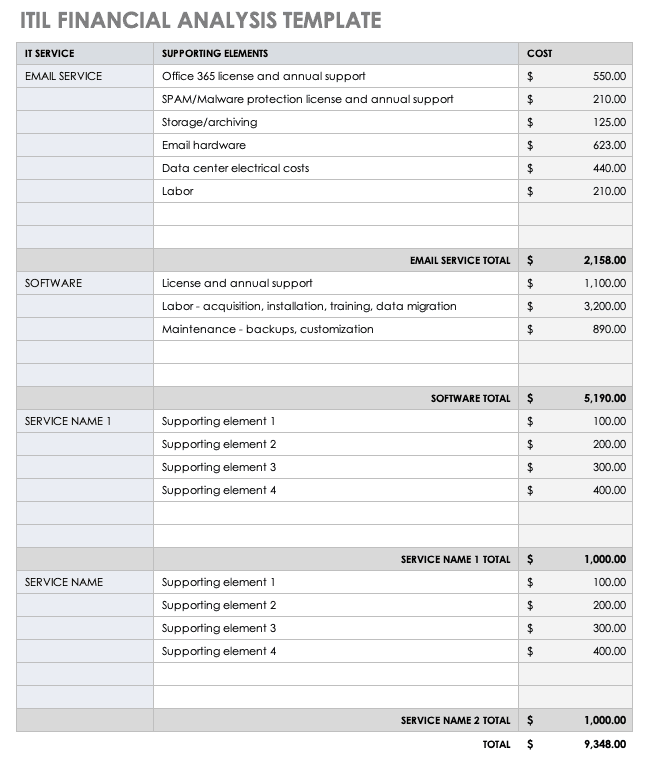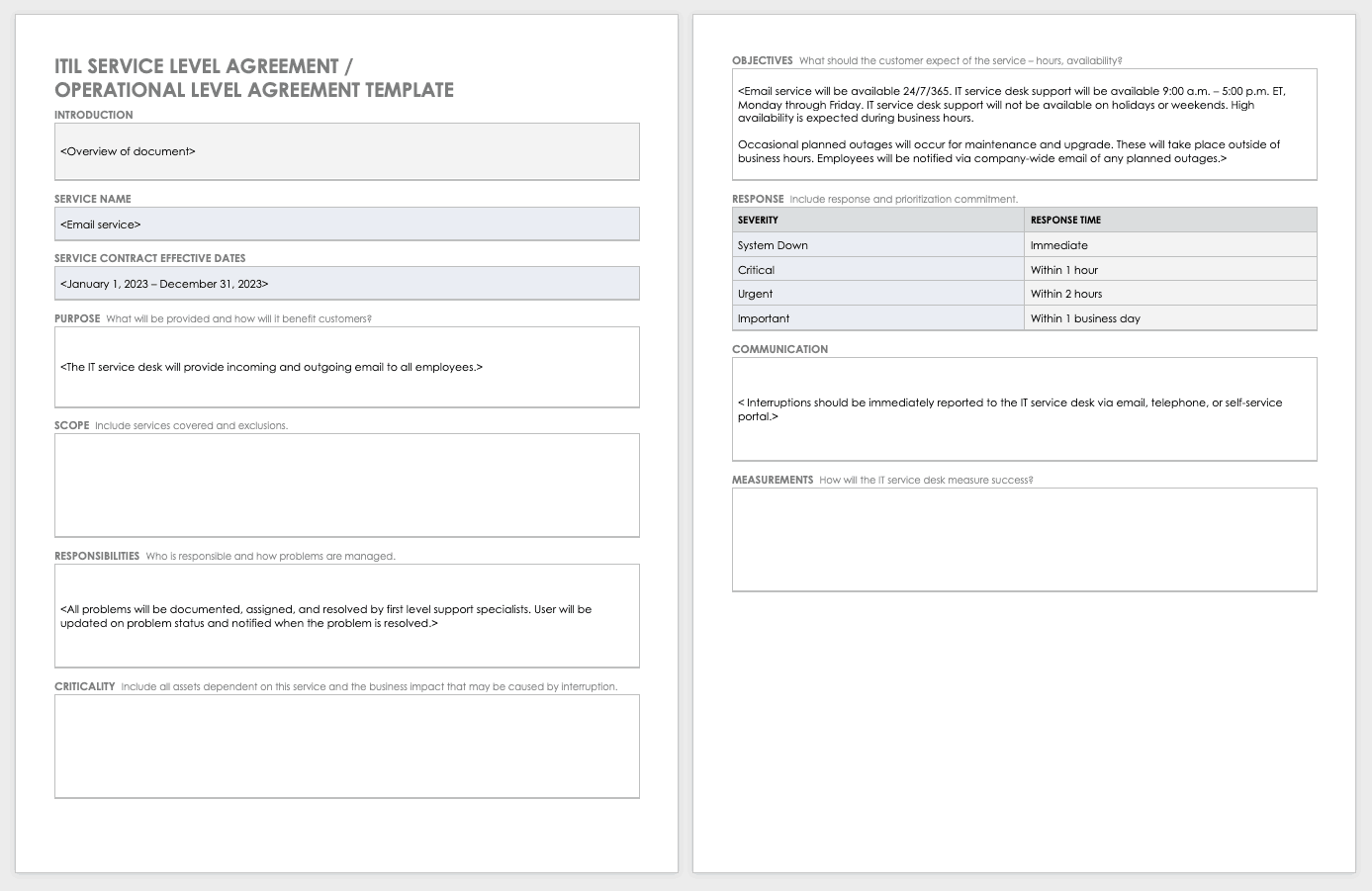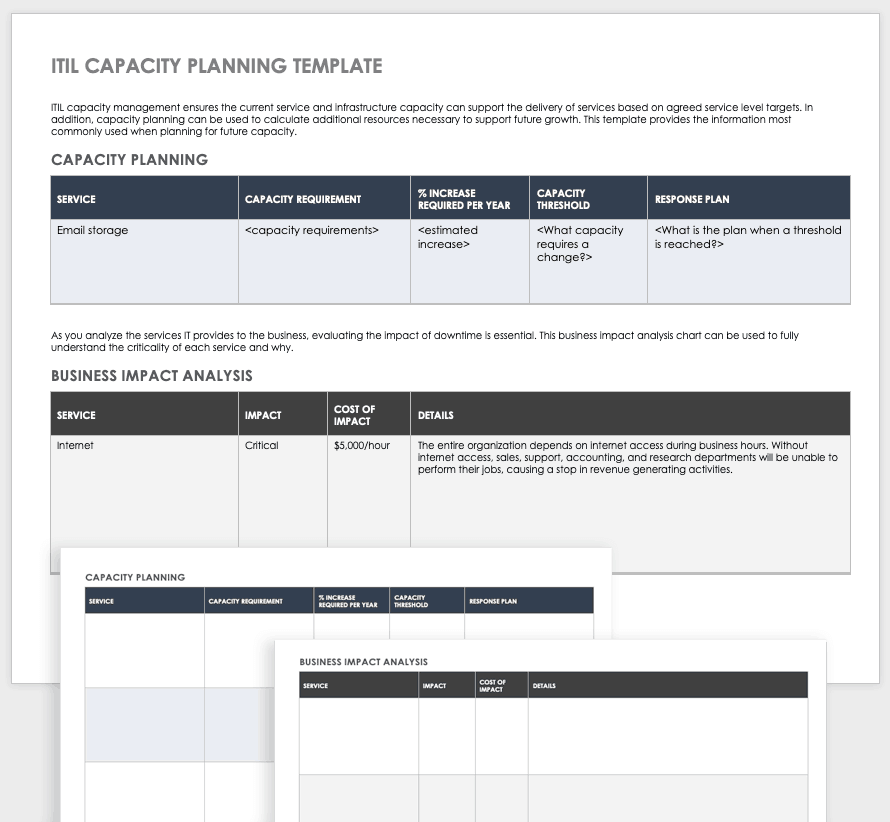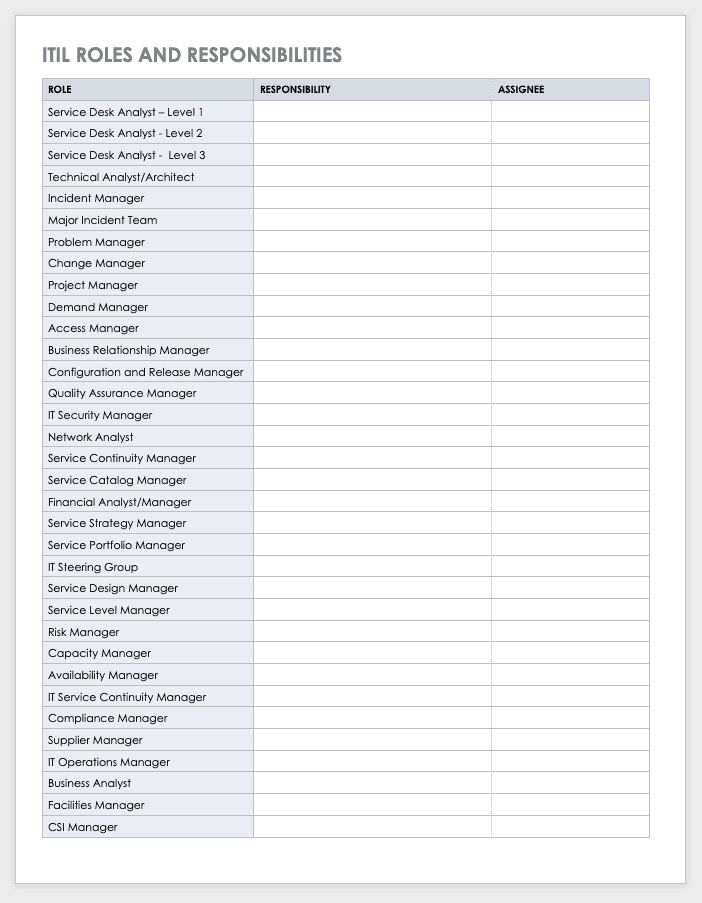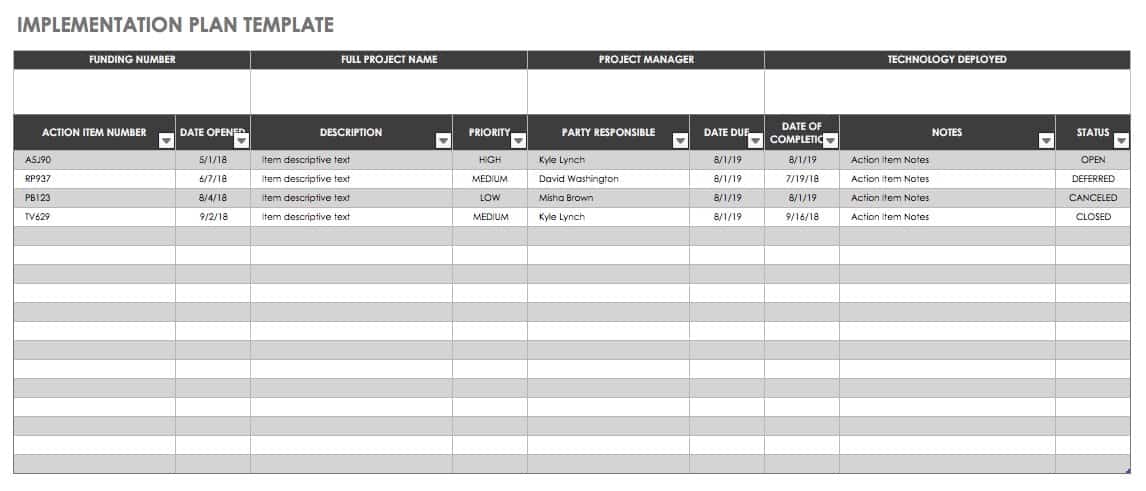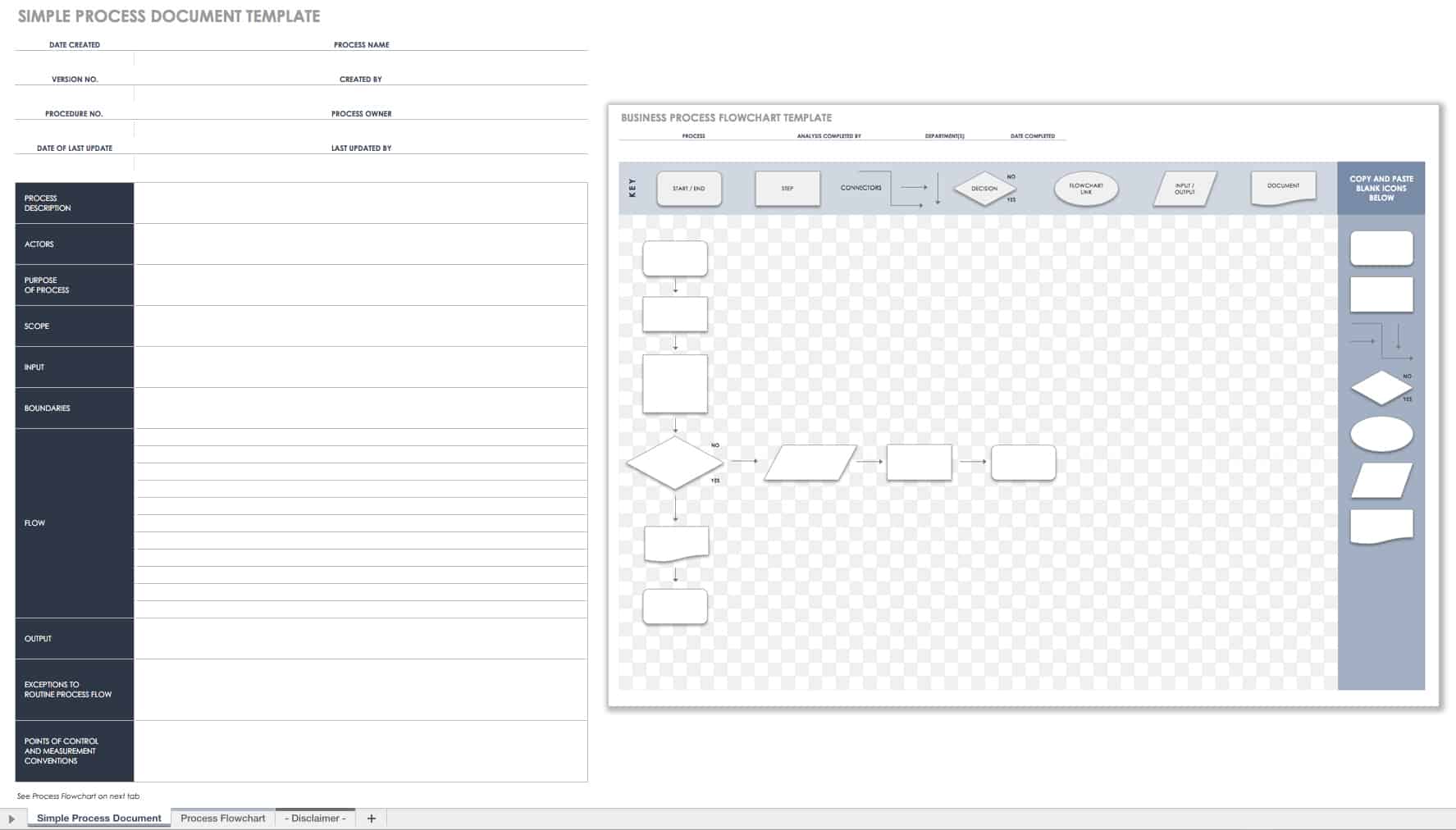ITIL Service Strategy Templates
ITIL service strategy focuses on defining the services that IT organizations deliver to customers. Below, you will find a service portfolio checklist and financial management analysis to help get started with these ITIL practices.
IT Service Portfolio Checklist
Understanding the value IT provides to a business is essential. An IT service portfolio is the starting point for understanding what IT does — how IT delivers business value by supplying essential IT services. The services that an IT team offers include IT systems, business services, and professional services.
A service portfolio can be used with or without a service catalog, but if you are going to design one, it’s essential to develop a service portfolio first. An IT service portfolio contains the complete set of services that an IT department manages.
This checklist guides the development of an IT service portfolio, which, in turn, supports the development of a service catalog. The checklist benefits management throughout the organization as well as IT team members by providing visibility into IT’s purpose.
Download ITIL Service Portfolio Checklist
IT Financial Management Analysis
ITIL financial management focuses on managing the value of IT-provided services by considering all associated costs. Accounting, budgeting, and how much to charge for services are all elements of IT financial management.
It is necessary to understand all the supporting services in order to calculate the total cost of the main IT service. Total cost should include capital costs, operational costs, fixed costs, and variable costs. You can use this template as a starting point to help calculate the cost of IT services. Some costs may require estimation and depreciation.
ITIL Service Design Templates
ITIL service design practices focus on coordinating the design of new, existing, and continuously improving IT services. Below, you will find templates to help you get started with service-level agreements (SLAs), operational-level agreements (OLAs), capacity planning, service availability, service continuity, supplier management, and service catalog management.
IT Service-Level Agreements and IT Operational-Level Agreements Template
SLAs and OLAs are developed as part of the ITIL service-level management practice. The goal is to deliver IT services based on the defined service-level targets. This template serves as a guide for the information that is typically included in an IT service-level agreement. You can also use this template to create operational-level agreements and underpinning contracts with third parties.
Download ITIL Service-Level Agreement/Operational-Level Agreement Template
IT Capacity Planning Template
ITIL capacity management ensures the current service and infrastructure capacity can support the delivery of services based on agreed-upon service-level targets. In addition, you can use capacity planning to calculate the additional resources necessary to support future growth. This template provides the information most commonly used when planning for future capacity.
Download ITIL Capacity Planning Template
IT Service Availability Report Template
Service availability focuses on measuring the reliability of IT services. Use this template to easily calculate and report on the percentage of time your IT services are available to customers.
Download ITIL Service Availability Report Template - Excel
IT Service Continuity Plan Template
IT service continuity management focuses on how to restore one or more IT services to ensure that a business can continue to operate. The IT service continuity plan is the formal strategy for restoring services in case the continuity of IT services is compromised. Use this template as a starting point for documenting procedures to follow if your business needs to recover critical IT services.
Download ITIL IT Service Continuity Plan Template
IT Supplier Management Template
The goal of supplier management is to ensure that all suppliers meet contract commitments and support the needs of a business. Use this template to manage all IT service providers and contracts.
Download Supplier Management Template
IT Service Catalog Template
The service catalog is a curated collection of all IT services, including information such as service status and service dependencies. This template aids in creating the list of IT services and the information that proves useful to IT customers and business stakeholders.
ITIL Service Transition Templates
The goal of ITIL service transition practices is to ensure that IT service deployment and the changes to those services take place in a smooth, coordinated manner. Below, you will find templates for a change request, service asset and configuration management, release management, and project management.
IT Request for Change Template
A change request is standard documentation in change management, and may include information on the person requesting the change, the change being requested, evaluation details, and the resolution. You can use this form to initiate a change control process and document the lifecycle of change requests and the request fulfillment process. You can modify this change request template to include the details needed for your specific change process.
IT Service Asset and Configuration Management Plan Template
The goal of service asset and configuration management is to plan and manage assets and configuration items that a business uses across all its departments. This template helps to capture the configuration item details essential to supporting ITIL practices. You can use these details to populate the configuration management database (CMDB) or configuration management system (CMS).
IT Release Management Checklist
ITIL Project Management Template
ITIL project management is focused on coordinating service transition practices in order to avoid or resolve conflicts. This template will help you plan, track, and visualize your project with an interactive timeline.
Download Agile Project with Gantt Template
ITIL Service Operation Templates
ITIL service operation practices focus on the day-to-day tasks and practices that take place to deliver IT services to business customers. In this section, you will find incident management, problem management, and event management templates.
ITIL Incident Record Template
The ITIL incident record template guides you through the data most commonly collected when an IT incident occurs, including SLA breach, IT service impacted, and major incident indicator.
Download ITIL Incident Record Template
ITIL Major Incident Review Template
ITIL Problem Record Template
The ITIL problem record template guides you through the data most commonly collected when an IT problem occurs, including root cause, associated incidents, and corrective actions.
ITIL Root Cause Analysis Template
Problem management focuses on identifying problems quickly, providing end-to-end management, and diagnosing the underlying root cause in order to prevent problems from reoccurring. Root cause analysis is the analysis or systematic investigation you perform to identify the fundamental cause of a problem.
There are various techniques you can use to perform root cause analysis. Depending on the problem, you can use techniques on an individual basis or in conjunction with one another. Here are some of the techniques professionals use to perform root cause analysis:
- Six Sigma DMAIC
- Brainstorming
- The 5 Whys
- Flowcharting
- Affinity Diagram
- Ishikawa Fishbone Diagram
- Chronology of events
- Kepner Tregoe Method
- Fault detection and isolation
- Rapid problem resolution (RPR)
Use this simple root cause analysis template to examine and analyze the root cause of IT problems.
Download Root Cause Analysis Template
You can find templates for several of the above mentioned approaches here and here, as well as additional decision making techniques.
ITIL Event Management Record Template
ITIL event management detects events that occur across a business’ IT infrastructure. Of the many events that can arise, some may be problematic, while others are simply part of normal operations. The goal of event management is to analyze events to determine if any action should be taken. Use the event management record template to help you ascertain which data you should collect for each event.
ITIL Continual Service Improvement Process Gap Analysis Template
The goal of ITIL continual service improvement (CSI) is to analyze data, such as critical success factors and key performance indicators, in order to detect opportunities for improvement across all IT practices and services. Use this gap analysis template to review services and practices, identify where they fall short, and plan for how to improve or update them.
This template includes an area to describe the practice or service, note the owner, and state the current and desired results. Use action items and target date areas to start developing a plan to make improvements. Doing this helps create a service/practice improvement plan.
Download Continual Service Improvement Process Gap Analysis Template - Excel
ITIL Roles and Responsibilities Template
The organization of people is an important part of the ITIL framework. Within an organization, you must define roles and teams in order to manage practices and ensure quality service delivery. It is not uncommon for one person to wear multiple hats.
For example, an incident manager may also be the problem manager. However, no matter how many staff members you have and how many hats they wear, it’s necessary to clearly define who is responsible for the practices and associated tasks.
You can use the following template to indicate roles and associated responsibilities. To get you started, the template includes Common IT and ITIL roles.
Download ITIL Roles and Responsibilities Template
ITIL Business Case Template
A business case helps stakeholders understand what it is that you want to do and how it benefits the business. Use this template to present a clear and comprehensive business plan for your ITIL initiative or development or change to an IT service.
Download Business Case Template
ITIL Implementation Plan Template
An implementation plan can support and guide any major initiative. ITIL practice implementation requires careful thought, so you can accurately consider the level of dependency on people, process, and technology. This implementation plan provides a standard, but scalable guide to organizing actions, prioritizing, assigning ownership, and tracking progress.
Download ITIL Implementation Plan Template
ITIL Practice Documentation Template
Documentation is a key element of defining and implementing ITIL practices. This template helps you gather practice purpose, flow, and roles and responsibilities. It also includes a visual flow chart for practice mapping. Customize the template by editing or adding sections based on your specific ITIL practices.
Download Practice Document Template
Free ITIL Practice Templates
ITIL provides best practices for delivering IT services to your business, but for many IT practitioners, this framework can be overwhelming. ITIL is not prescriptive, but rather allows organizations to flexibly apply practices based on their unique business needs. ITIL templates make it easier to get started with the framework by providing visual, tangible documents to work with.
Templates can act as a reference guide for ITIL practices by doing the following:
- Demonstrating the purpose, scope, risks, and business value of a typical ITIL initiative
- Documenting historical data
- Clarifying definitions, descriptions, and abbreviations
- Modeling process inputs and outputs
- Guiding practice setup through flow charts
- Aiding in ITIL practice application
We will discuss ITIL in more detail below.
What Is ITIL and the ITIL Service Value System?
ITIL dates back to the 1980s, when the British government launched an initiative to improve the quality of IT services delivered to government agencies. The goal was to create a high-quality, cost-effective IT service delivery framework. Over the years, this framework has gone through various naming conventions, experienced changes in agency ownership, and enjoyed adoption growth across both government and non-government sectors.
Today, Axelos is the U.K. government organization charged with managing all frameworks and methodologies. The most recent ITIL update, ITIL 4, came out in early 2019, and incorporates the most modern trends in IT operations, such as Agile, DevOps, and Lean.
ITIL Practices
ITIL 4, renames “ITIL processes” as “ITIL practices” and organizes these 34 practices across three categories: general management practices, service management practices, and technical management practices. The table below categorizes the 34 practices.
General Management Practices | Service Management Practices | Technical Management Practices |
|---|---|---|
Architecture Management | Availability Management | Deployment Management |
Continual Service Improvement | Business Analysis | Infrastructure and Platform Management |
Information Security Management | Capacity and Performance Management | Software Development and Management |
Knowledge Management | Change Control | - |
Measurement and Reporting | Incident Management | - |
Organizational Change Management | IT Asset Management | - |
Portfolio Management | Monitoring and Event Management | - |
Project Management | Problem Management | - |
Relationship Management | Release Management | - |
Risk Management | Service Catalog Management | - |
Service Financial Management | Service Configuration Management | - |
Strategy Management | Service Continuity Management | - |
Supplier Management | Service Design | - |
Workforce and Talent Management | Service Desk | - |
| - | Service-Level Management | - |
| - | Service Request Management | - |
| - | Service Validation and Testing | - |
Benefits of ITIL Templates
Thousands of organizations around the world have adopted ITIL, and the framework continues to expand. ITIL’s unique terminology and number of practices may feel overwhelming, but templates can help you collect necessary details and plan for a successful implementation. With the range of concise, easy, and practical templates, plans, and checklists included in this article, you’ll be equipped to write a solid service-level agreement, define the contents of a problem, incident, and event record, establish rules, improve practices using a gap analysis, and much more.

